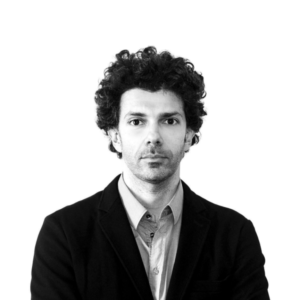It seems we can’t find what you’re looking for. Perhaps searching can help.
The Introductory Studio G1: The Future of Density, Rethinking the Cerdá Block, examines how housing can adapt to global challenges such as climate change, migration, resource scarcity, and technological transformation. Working at the scale of Barcelona’s Cerdà block, students explore density as an opportunity for resilience—designing systems that integrate ecology, technology, and collective living to imagine the future of urban habitation.
Syllabus

Credits: Synergy Station, Introductory Studio, MAA01 2023/24
Housing is one of the most urgent challenges of the twenty-first century. UN-Habitat estimates that by 2030, over three billion people will need access to adequate housing. At the same time, cities like Barcelona face geographical and political limits to expansion, caught between sea, mountains, and administrative borders. Density becomes the inevitable terrain of speculation. How we live together in limited space will define the social, ecological, and technological futures of urban life.
Ildefons Cerdà’s nineteenth-century plan set the foundations for Barcelona’s future, imagining equal access to light, air, and infrastructure. The question is how this urban unit can evolve under conditions Cerdà could not foresee: climate crisis, demographic transformation, resource depletion, and the rise of artificial intelligence.
The ways of living that defined the industrial city are shifting. Families fragment, work infiltrates domestic space, and digital networks alter how communities form and dissolve. As philosophers such as Richard Sennett have argued, the city is a site of cooperation and conflict, where collective life must constantly be renegotiated. For Saskia Sassen, global flows of capital and migration reconfigure urban space as much as local governance. Architecture cannot respond with typological repetition alone. It must speculate on new systems of habitation that integrate ecological, social, and technological realities.
This studio situates housing as a systemic problem. Following the systems thinking of Donella Meadows and the antifragility of Nassim Taleb, students will be asked to consider not only form but the networks of resources, infrastructures, and species that sustain life within the block. Housing density is understood as both risk and opportunity: compactness may strain resources, but it may also catalyze circular metabolisms, shared infrastructures, and resilient communities.
To focus the inquiry, six global problematics are defined. Each describes a pressure that will intensify in the coming decades, and each offers a pathway for speculation on the future of density:
- Climate Adaptation and Energy
Mediterranean cities are entering an era of prolonged heat waves, higher night-time temperatures, and increasing weather volatility. Dense urban fabrics intensify these dynamics, amplifying the heat island effect and straining public health. At the same time, energy infrastructures are stressed precisely when demand for cooling peaks. Housing can no longer depend on mechanical systems alone. Its section, envelope, and microclimate must act as active regulators of comfort, producing local conditions that mediate between extreme climates and human habitation.
Parallel to the climatic crisis, the technological boom of artificial intelligence, blockchain validation, and global data infrastructures is driving an unprecedented surge in electricity consumption. Energy grids are reorganized around the appetite of large enterprises, often leaving the domestic consumer vulnerable to volatility and scarcity. In this context, securing energy becomes a defining question of urban living. How can future housing ensure autonomy and resilience when both natural systems and technological systems converge to destabilize supply?
- Migration and Demographic Shifts
The demographic foundations of housing are undergoing profound change. Declining birth rates and an aging population alter the balance between generations, while shrinking household sizes challenge the family-based typologies of the industrial city. Migration flows, driven by inequality and climate pressures, reshape the social fabric of urban centers, introducing new cultural and spatial demands. Tourism, meanwhile, continues to cannibalize local housing supply, displacing residents and inflating costs. These overlapping pressures destabilize access to housing and expose vulnerabilities in how cities allocate space.
In the Mediterranean, the situation is further complicated by seasonal work, study migration, and the rise of digital nomads who circulate with temporary patterns of residence. Tenure precarity, affordability crises, and gentrification fragment communities, making permanence increasingly rare. Housing density must therefore be conceived as variable across both space and time, able to accommodate cycles of occupation, intergenerational coexistence, and transient forms of life. The speculative question is how future models of density can adapt to these shifting demographics while maintaining equity, stability, and a sense of collective belonging.
- Food and Water Security
The Mediterranean faces an escalating risk of drought, with shrinking reservoirs and rising competition for water across agriculture, industry, and domestic use. Urban cooling systems, sanitation, and food preparation all rely on increasingly fragile supplies. At the same time, fertile land becomes scarcer as cities expand and soils degrade, leaving less space for agriculture close to where people live. Food production near consumption reduces transport and increases resilience, but requires cycles of water, nutrients, and sunlight that dense housing has historically ignored.
Globalization once promised reliable access to affordable food, yet political instability, protectionist policies, and the fragility of global supply chains now threaten that stability. Access to healthy nutrition is increasingly shaped by geopolitical shocks, polarized rhetoric, and trade disputes. In this shifting landscape, communities must confront the possibility that imported staples may no longer be available or affordable. The question for the future is how dense urban environments can contribute to food and water security, creating metabolic systems that sustain inhabitants when global networks falter.
- Technology and AI
Artificial intelligence, robotics, and pervasive data infrastructures are rapidly reshaping domestic life. Predictive systems manage maintenance and energy, while algorithmic scheduling organizes shared amenities and logistics. Delivery drones, cleaning robots, and voice interfaces have already entered homes, and the next horizon is humanoid robots acting as the physical embodiments of AI. These machines will alter how space is organized, how privacy is negotiated, and how care and service are delivered inside dense housing. The dwelling becomes a human–machine interface where thresholds, ergonomics, and circulation respond as much to non-human actors as to human ones.
Beyond the home, AI transforms the very conditions of society. Automation threatens to reduce the need for human labor in production, administration, and even creative domains. Debates around universal basic income, the end of traditional employment, and the redistribution of value become inseparable from the way we design where and how we live. Technological utopias envision efficiency, abundance, and freedom from work, while dystopias warn of surveillance, dependency, and exclusion. Housing density will stand at the center of this debate, either as a field where technology amplifies care and collective intelligence or as one where it entrenches inequality and control. The question is how architecture can anticipate and shape these trajectories rather than merely adapt to them.
- Resource Depletion
The twentieth century was built on the illusion of infinite growth on a finite planet. Today the extraction of sand, aggregates, metals, and fossil fuels is straining ecosystems and destabilizing supply chains. Embodied carbon already rivals operational emissions, even as buildings become more efficient in use. The pace of obsolescence in finishes, appliances, and infrastructures accelerates waste streams that cities struggle to process. As resource costs rise and volatility increases, the construction sector will confront limits that cannot be deferred indefinitely.
The shift required is conceptual as well as technical. Waste must be recognized not as an inevitable byproduct but as a design flaw. Ideas from cradle-to-cradle thinking, the Blue Economy, and circular design demand that materials circulate in continuous loops rather than flow linearly from extraction to disposal. Additive processes replace extractive ones, revaluing local, renewable, and bio-based materials. Housing in this future must be conceived as adaptive and reversible, with components that can be maintained, reconfigured, and recovered rather than discarded. The challenge is to reframe density not as a pressure on scarce resources but as a catalyst for collective material intelligence, where what we build becomes the quarry of tomorrow.
- Biodiversity Collapse and Urban Ecologies
The accelerated decline of species and ecosystems undermines the very foundations of human life. Pollination, flood prevention, soil regeneration, and thermal moderation are not luxuries but essential services that cities increasingly struggle to replace with artificial means. Dense housing compounds the crisis by sealing soil, fragmenting habitats, and reducing the range of species that can survive in urban conditions. To reverse these trends, biodiversity must become a design parameter, integrated into the conception of density rather than added as an ornamental layer.
The value of biodiversity extends beyond immediate services. It represents an almost infinite reservoir of potential discoveries, from medicines to materials, and a source of resilience against shocks we cannot predict. Every species plays a role in the intricate planetary network, and the collapse of one accelerates the fragility of others. Humans are embedded in this system, not outside of it. Future housing must therefore foster and cultivate surrounding ecologies, creating habitats, corridors, and conditions that allow life to proliferate. The challenge for density is to demonstrate that urban living can enhance biodiversity rather than diminish it.
Students will explore these problematics through research and speculation, projecting futures for living. The studio will emphasize density as a variable condition (vertical, compact, porous, or hybrid) rather than a fixed typology. Emerging technologies, ecological knowledge, and systemic design approaches will inform housing prototypes that respond to the chosen problematic at the scale of the Cerdà block.
The ambition is to design housing not as isolated units but as systems embedded in larger ecologies and societies. By rethinking density, the studio seeks to imagine how the Cerdà block can once again serve as a projective model for the city of the future.
Learning Objectives
The course’s overall goal is to speculate on how the future of housing density will be planned, designed, and inhabited under the pressures of planetary change. Students will be asked to confront housing not only as a typological challenge but as a systemic condition where energy, resources, technology, and society converge.
The project will investigate six global problematics that will intensify in the coming decades: climate adaptation and energy, migration and demographic shifts, food and water security, technology and artificial intelligence, resource depletion, and biodiversity collapse. Each student will focus on one, using it as a lens to reimagine new forms of domesticity within conditions of density.
Students will be encouraged to understand density as a variable and adaptive framework. Compactness, verticality, porosity, and hybrid models will be explored as possible futures, questioning how they can absorb population shifts, ecological limits, and technological disruptions.
The studio will emphasize systemic thinking. Following Donella Meadows, housing will be studied as a node within larger cycles of resources, infrastructures, and species. Drawing on Nassim Taleb’s notion of antifragility, students will consider how dense housing can not only withstand shocks but evolve through them.
Emerging technologies will be integrated into the design process. Artificial intelligence, robotics, and generative workflows will be employed as tools for research and speculation, translating complex systems into spatial and architectural proposals. Students will learn to critically balance the potentials of computation with the uncertainties of future living.
In a word, the students will design the future of density, developing housing systems that integrate novel technologies, ecological cycles, and adaptive spatial organizations able to respond to global pressures and societal transformations. Their projects will explore how housing can mediate between climate, resources, and technological change, while fostering resilience and adaptability within limited urban space. Thus, the students will also be able to examine more in depth the relationship between density and ecology, between artificial intelligence and human community, and between the dwelling, the collective, and the city.





